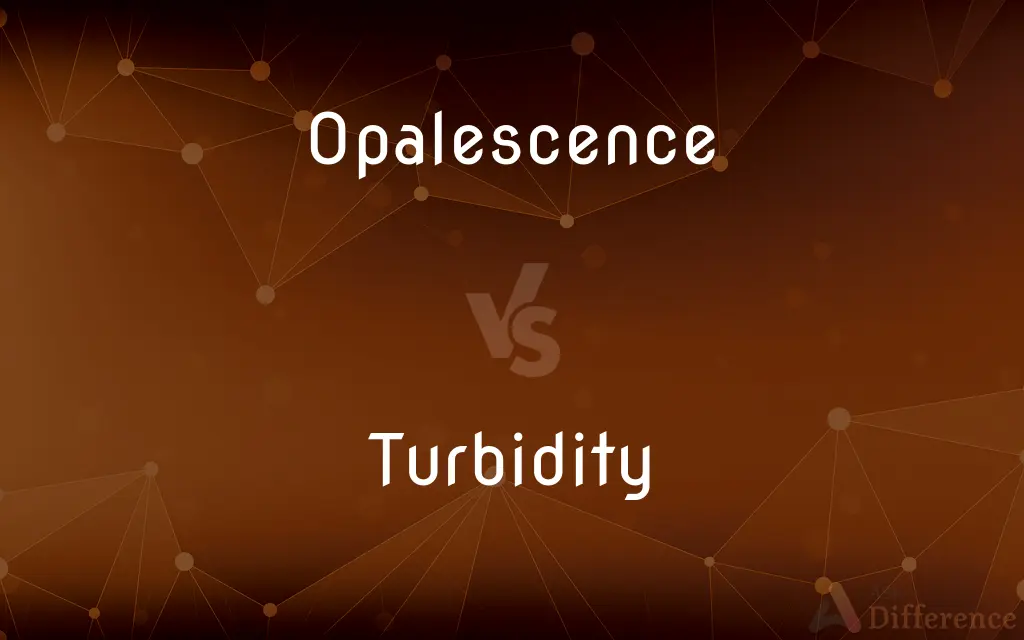Opalescence vs. Turbidity — What's the Difference?
By Tayyaba Rehman — Updated on October 17, 2023
Opalescence is the iridescent play of colors in certain materials, resembling opal, while Turbidity refers to the cloudiness or haziness of a fluid due to suspended particles. Both describe visual properties but with different causes and appearances.

Difference Between Opalescence and Turbidity
Table of Contents
ADVERTISEMENT
Key Differences
Opalescence and Turbidity are both terms used to describe specific optical properties in materials or liquids. Opalescence is often associated with a shimmering, rainbow-like appearance, similar to that seen in opals. This visual phenomenon occurs due to the diffraction of light within the substance. Turbidity, on the other hand, denotes the degree to which a liquid is cloudy or hazy due to the presence of suspended particles.
When observing a material exhibiting Opalescence, one might notice a play of colors, often shifting and changing as the angle of observation changes. This is a result of light interacting with the internal structures or layers of the material. In contrast, Turbidity does not exhibit color play. Instead, it signals a decrease in the clarity of a fluid, making it look murky or opaque.
In gemology, Opalescence is a prized quality, especially in gems like moonstone. The internal structures of these stones scatter light in a unique way to produce this effect. Turbidity, however, is primarily a term used in environmental science and chemistry. High Turbidity in water, for instance, can indicate pollution or the presence of many microorganisms.
The appreciation of Opalescence is subjective, with many finding it aesthetically pleasing, especially in jewelry. Turbidity, conversely, is often seen as a negative quality, especially in contexts like drinking water, where clear water is preferred for safety and aesthetic reasons.
Both Opalescence and Turbidity can be quantified, albeit for different purposes. Instruments can measure the degree of Turbidity in water samples, which is crucial for environmental and health assessments. Opalescence, while often appreciated subjectively, can also be studied using optical instruments to understand its cause and characteristics.
ADVERTISEMENT
Comparison Chart
Nature
Iridescent play of colors
Cloudiness due to suspended particles
Caused By
Diffraction of light
Suspended particles in a fluid
Field of Study
Gemology
Environmental science, Chemistry
Aesthetic Perception
Often appreciated (e.g., in gems)
Typically seen negatively (e.g., in water quality)
Measurement
Can be studied using optical instruments
Measured using specific instruments to determine clarity of a fluid
Compare with Definitions
Opalescence
The play of rainbow-like colors in a material.
The Opalescence of the gem caught her eye.
Turbidity
The degree of haziness in a fluid.
They tested the Turbidity of the sample before analysis.
Opalescence
A shimmering visual effect in certain materials.
Moonstones are known for their striking Opalescence.
Turbidity
The cloudiness in a fluid due to suspended particles.
The river's Turbidity increased after the storm.
Opalescence
Iridescent light diffraction resembling opal.
The glass exhibited a stunning Opalescence.
Turbidity
The state of being murky or opaque.
The Turbidity of the lake made it hard to see beneath the surface.
Opalescence
The quality of reflecting light in varied colors.
The vase had a unique Opalescence under sunlight.
Turbidity
Impaired clarity caused by dispersed matter.
Industrial waste can significantly increase the Turbidity of water sources.
Opalescence
Opalescence refers to the optical phenomena displayed by the mineraloid gemstone opal (hydrated silicon dioxide). However, there are three notable types of opal (precious, common, and fire), each with different optical effects, so the intended meaning varies depending on context.
Turbidity
A measure of the clarity of a liquid.
High Turbidity in drinking water can be a health concern.
Opalescence
Exhibiting a milky iridescence like that of an opal.
Turbidity
In a state of turmoil; muddled
Turbid feelings.
Opalescence
The state of being opalescent
Turbidity
Muddiness created by stirring up sediment or having foreign particles suspended
Opalescence
(physics) the milky iridescent appearance of a dense transparent medium when it is illuminated by polychromatic visible radiation (such as sunlight) due to local fluctuations in its density and therefore in its refractive index
Turbidity
Turbidity is the cloudiness or haziness of a fluid caused by large numbers of individual particles that are generally invisible to the naked eye, similar to smoke in air. The measurement of turbidity is a key test of water quality.
Opalescence
A reflection of a milky or pearly light from the interior of a mineral, as in the moonstone; the state or quality of being opalescent.
Turbidity
Having sediment or foreign particles stirred up or suspended; muddy
Turbid water.
Opalescence
The visual property of something having a milky brightness
Turbidity
Heavy, dark, or dense, as smoke or fog.
Opalescence
A lustrous, changing play of light.
Artists often try to capture the Opalescence of the sea at dawn.
Turbidity
The state of being turbid; turbidness.
Turbidity
The measure of transparency of a fluid (units of measurement include Nephelometric Turbidity Unit (NTU)).
Turbidity
Turbidness.
Common Curiosities
Is Opalescence found only in opals?
No, while opals are known for it, other materials like moonstone can also exhibit Opalescence.
What does Turbidity indicate?
Turbidity refers to the cloudiness or haziness of a fluid caused by suspended particles.
What is Opalescence?
Opalescence is the iridescent play of colors in certain materials, resembling the appearance of opal.
Is high Turbidity in water always bad?
High Turbidity can indicate pollution or many microorganisms, potentially making the water unsafe.
Is Opalescence the same as iridescence?
While similar, Opalescence specifically resembles the play of colors in opals.
What can cause high Turbidity in rivers?
Soil erosion, waste discharge, and algal growth are common causes.
Does Turbidity affect aquatic life?
Yes, high Turbidity can harm aquatic ecosystems by blocking light and affecting oxygen levels.
How is Opalescence caused?
It's caused by the diffraction of light within the substance, producing a play of colors.
Is Opalescence a natural phenomenon?
It can be natural, as in gems, or artificially produced in materials like glass.
Can you reduce Turbidity in water?
Yes, through filtration, sedimentation, and other purification methods.
Can Opalescence be artificially created?
Yes, certain materials can be crafted to exhibit Opalescence.
Do all opals show Opalescence?
No, but many opals, especially precious opals, exhibit this phenomenon.
Why is Turbidity measurement important?
It's crucial for assessing water quality, environmental health, and safety for consumption.
What instruments measure Turbidity?
Turbidimeters or nephelometers are commonly used.
Share Your Discovery

Previous Comparison
Vigilant vs. Wary
Next Comparison
Vibratome vs. MicrotomeAuthor Spotlight
Written by
Tayyaba RehmanTayyaba Rehman is a distinguished writer, currently serving as a primary contributor to askdifference.com. As a researcher in semantics and etymology, Tayyaba's passion for the complexity of languages and their distinctions has found a perfect home on the platform. Tayyaba delves into the intricacies of language, distinguishing between commonly confused words and phrases, thereby providing clarity for readers worldwide.
















































